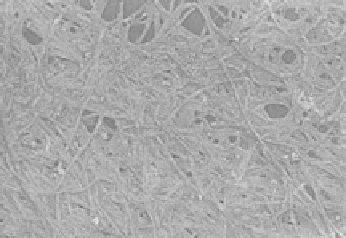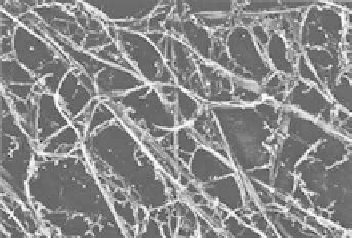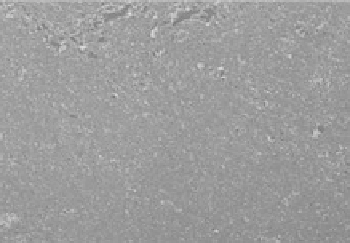Biomedical Engineering Reference
In-Depth Information
9.5.3
BC/Pectin Nanocomposites
BC/pectin nanocomposites were also prepared in vitro and extensively characterized
(58-61). Pectin consists of galacturonans, galactans and arabinans. For pectin to be
incorporated in the BC network, calcium binding was required, and pectins having a
lower degree of methyl substitution were more easily incorporated (60). The morphology
of the BC/pectin nanocomposites differed greatly from the crosslinked and intimately
mixed morphology observed with glucans and mannans. Interpenetrating networks of
pectin bacterial cellulose formed when a slightly crosslinked pectin network existed in
the growth medium of BC (60). Pectin was found to aggregate next to cellulose fibrils
leaving voids of intermediate size between that of the cellulose and pectin networks
alone (Figure 9.24). However, pectin did not alter the width of the cellulose fibers
nor their crystallinity (60). In the absence of preexisting slightly crosslinked pectin
network, the BC/pectin nanocomposites developed as a phase separated material of BC
and pectin. With solid state NMR the absence of molecular interactions between pectin
(a)
(b)
(c)
(d)
Figure 9.24
Micrographs of (a) pectin/Ca2
+
gel (b) Acetobacter cellulose (c) Ace-
tobacter cellulose/pectin/Ca2
+
composite (BC:Pectin in 60:40) and (d) Acetobacter
cellulose/pectin/Ca2
0
.
5
µ
m. (Chanliaud, E.;
Gidley,M. J., InVitrosynthesisandpropertiesof pectin/Acetobacterxylinuscellulosecom-
posites. Plant Journal, 1999, 20, 25-35. Copyright 1999. Reprintedwith permission from
Wiley-Blackwell.)
+
composite (BC:Pectin in71:29). Scalebar
=




Search WWH ::

Custom Search